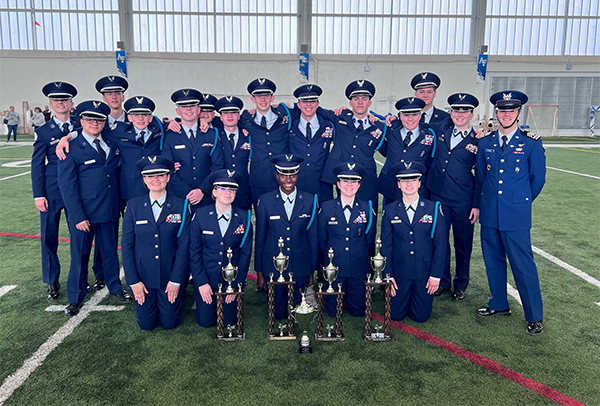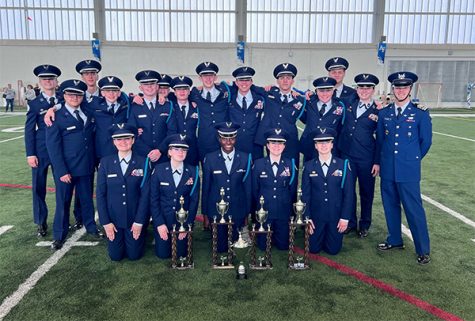JROTC drill team rises early to prepare for nationals

The Blue Springs South Air Force JROTC drill team poses with their trophies at the Air Force Academy in Blue Springs. Photo submitted
May 24, 2022
By Olivia Svoboda
Copy Editor

One of the greatest parts of school extracurriculars is getting to show off your hard work in front of your peers, whether that be on the court, field, track, or stage. There’s plenty that goes on behind the scenes, too, though, including the work of the JROTC drill team. The group competed at nationals, a feat that many students had not heard about.
Colonel Stan Cole teaches some of the JROTC classes and leads the drill team. This is the first time the team has gone to nationals at the Air Force Academy in Colorado.
“The Air Force Academy is hosting the national invitational drill meet, and so they sent out invitations to a bunch of colleges and high school programs, and then we ended up on their list of people that they would like to come, so they asked us if we wanted to come,” Cole said.
The drill team has been working hard for this opportunity, placing high in the competitions they’ve been in throughout the year.
“We went to seven meets this year, and we finished in the top three in six of them, and like, fourth overall in the seventh one. So, we were basically top three all year long, which was awesome, and I think we ended up first place in two of them,” Cole said.
The drill team is completely different from any other school group, and it’s a little hard to understand without seeing a performance. There are multiple categories for different types of routines: there’s the unarmed category, where the drill team follows a set routine and marches. Then there’s the armed category, which has mock rifles included in the routine. Both teams are made up of nine people. There is also unarmed and armed exhibition, where the team gets to create their own routine and then march it. Finally, there’s color guard, which is a team of four marching.
During routines, cadets will synchronize their movements to the calls of their commander. Whether that command is to march in a certain direction, do a certain movement, or manipulate the mock rifle in a certain way, the cadets must be precise and exact, or points will be deducted.
Lilly Dunn is a senior and a commander for the drill team. As a commander, she is a leader of the team. Commanders must call the routine correctly, making sure the team is always doing the right movements.
“I just keep track of making sure everybody is prepared for the competition as far as having uniforms together and stuff like that, and I lead the team around. And if I see somebody struggling with something, it’s my job to go and make sure that the commanders are all getting done what they need to get done and getting the team ready,” Dunn said.
The team prepared differently for nationals this year, because they performed on a football field, instead of the usual gym floor.
“We normally perform on a gym floor where it’s really echoey, and we can hear each other, but this one is on turf, and it’s basically on a big football field. So, you can’t hear anybody,” Dunn said.
Along with the routines that the team performed, they also had to prepare for inspection.
“They go in there, and they grade you on your uniform and make sure that everything looks like it’s in order and lined up correctly, and they’ll check your shoes, make sure they’re shiny, and then they’ll make sure that you are knowledgeable about ROTC,” Dunn said. “They can ask us a wide range of questions. It can either be uniform, like what a certain thing means, or what a ribbon is for an achievement. They can ask anything about the Air Force, or they might ask us who’s in charge of something, or a historical date.”
The drill team usually practices before school, unlike most other activities. They must wake up bright and early so they can put the work into the routines and information they must memorize.
Senior Master Seargent Courtney Jones also teaches some of the JROTC classes, along with leading the drill team, too.
“We’ll take, let’s say exhibition, so we’ll do exhibition Monday morning at six o’clock. A little bit before six they show up, they put on their drill shoes and then we talk real quick and then run upstairs. And repetition, just going over it constantly and tweaking all the little movements and everything; making sure we look good. It’s a lot of repetition,” Jones said.
It’s no easy task to memorize a routine that’s eight minutes long. There are no directions in the final performance, so the team must know every move with sharpness and precision.
“It’s frustrating to learn how to throw the rifles and to learn these routines. And like most people, you want to be able to pick it up quick. But you can’t. You have to be patient with it and work hard. So just being able to stay focused is tough,” Jones said.
Though the drill team’s routines can be difficult and time-consuming to learn, they still have fun with each other.
Anthony Lorek is a sophomore, and he is also a commander on the drill team.
“I just like the precision. I love marching. I like hanging out with people around me, and I like doing the routines and doing all that with people,” Lorek said.
Nationals happened in April, but before then, the drill team continued to rehearse their routines until they were perfect. They were able to show off their dedication at the competition, where they were among many other drill teams and military personnel.
The students of Blue Springs South have been unable to see them perform, though, at least not in person.
“A lot of people don’t know what it is like. You hear drill team, and you might think of like a dance team or something, right? Instead of a military drill team. So, I guess I would hope that we could get some performances in the future, so that we could let the school see what the kids can do,” Cole said.
The drill team placed second at nationals.
